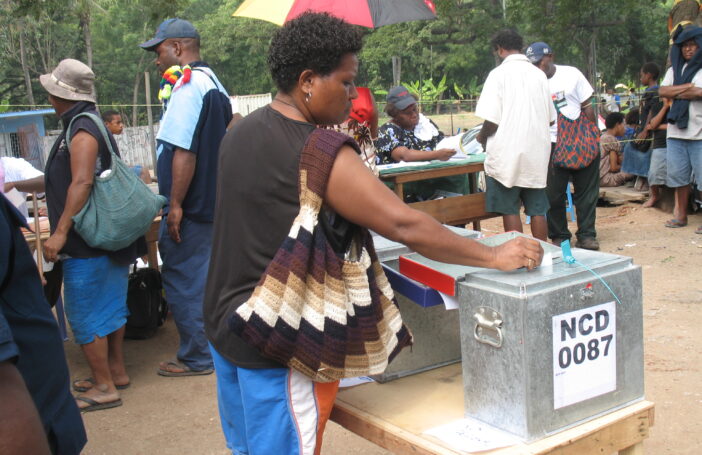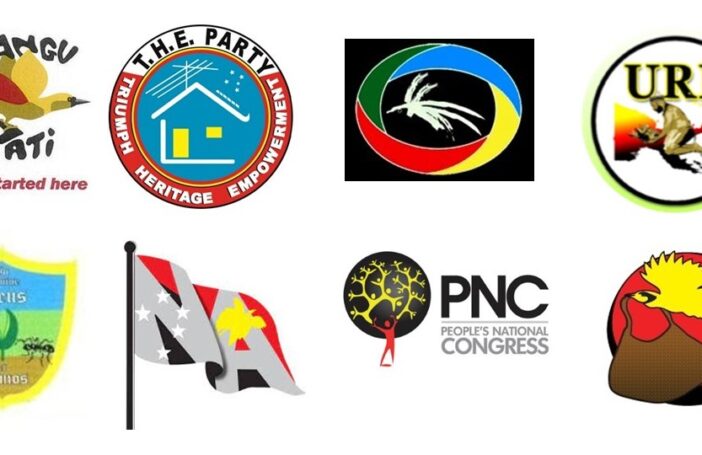Despite the increasing number of women contesting in national elections in Papua New Guinea, and the excitement of having three women elected in 2012, women’s overall performance in proportion to their male counterparts remains somewhat stagnant. In this blog post, I examine election data in reference to how Papua New Guinean women candidates fare at the polls and highlight some challenges for women contesting in the coming 2017 elections.
Women have been contesting in national elections since 1972. In that first election, only two women contested. One of them, Dame Josephine Abaijah, became the first female member of parliament. In the 1977 elections, nine women contested and two were elected. In 1982, ten women contested and Abaijah lost her seat, leaving no women in parliament. Fifteen women contested in 1987 and 16 in 1992 without changing the gender profile.
Then in 1997, a total of 48 women contested. The substantial increase was attributed to numerous training workshops carried out by the National Council of Women in partnership with other non-government organisations (Sepoe 2002 [pdf]). Only two women were successful, Dame Carol Kidu and Dame Josephine Abaijah.
In the 2002 national elections, 75 women and 2,800 men contested. Dame Carol Kidu retained her seat by attaining 24 per cent of the votes. She ascribed her success to several reasons: she was already a sitting member, hence her ‘hand mark’ was visible to the people; she had a large voting base; and she had strategically used her electoral funds to capitalise on her chances of re-election (Kidu and Setae 2002 [pdf]). On average, the other 74 women contestants received less than 3 per cent of the total allowable votes, with some figures as low as 0.3 and 0.6 per cent.
In the 2007 elections, 103 women contested (3.7 per cent of the total 2,759 candidates) (Sepoe 2011 [pdf]). Only Dame Carol Kidu retained her seat. During her last term in parliament, Dame Kidu tried to have the 22-reserve seats bill passed (the bill was not successful). The 2012 elections saw 135 female contestants (4 per cent of the total 3,447 candidates). Of these, only three women won: Delilah Gore (Sohe Open), Loujaya (Toni) Kouza (Lae Open) and Julie Soso, for the Eastern Highlands provincial seat. In the past three elections, on average, one female contested for every 28 male contestants.
Introducing limited preferential voting
It was suggested that the limited preferential voting (LPV) system would favour female voters, giving them more freedom at the polls, which could have a positive effect on female candidates (Haley and Zubrinich 2013). The LPV system was debated from 1993; it was only in 1999 under the Morauta government that substantial steps were taken to implement it (May 2003). The LPV system was used in the 2002 by-elections in various electorates and was fully implemented nationwide at the 2007 elections. With the LPV system, voters are required to list their preferences from one to three on the ballot paper.
Although more women vote and contest than before, women candidates still perform poorly (Haley and Zubrinich 2013). The election data show that most female candidates on average get only 2 per cent of the first preference votes in their respective electorates and a lot of them get eliminated well before the tenth count.
In the 2012 elections, Janet Sape, candidate for Port Moresby North-West, got 9 per cent of the first preference votes. The three winning women of 2012 attained 8 per cent of the first preference votes and managed to pick up votes from exhausted ballots at each successive count, which eventually led to their wins.
Of the three winners, Julie Soso was the only ‘regular’ because she’s been contesting since 1997, so the Eastern Highlanders were familiar with her. Moreover, as daughter of a clan leader and a businesswoman herself, she was financially able to fund her campaigns. Soso, as a long-time contestant, acknowledged her success was based on the LPV, as it was the second and third preference votes that carried her through (Swan and Walton 2013). First time contestant Delilah Gore is also daughter of a chief in her electorate. Gore established herself as a concerned public servant about the developmental needs of her community, and in doing so earned the respect and votes of the Sohe people (Chandler 2013). In an interview with John Eggins on Papua New Guinea’s EM TV Tok Piksa, Loujaya (Toni) Kouza, member for Lae Open, spoke of her ‘out of the ordinary’ campaign, in which she walked to all 16 wards of Lae with the flag of Israel[1] and her husband, connecting with the locals to rally support and reach people in various communities.
Under the Organic Law on Integrity of Political Parties and Candidates, political parties are encouraged to endorse female candidates, yet political parties are generally known to endorse and support strong candidates who are likely to win (Okole 2005 [pdf]), usually not women. In 2007, more than 60 per cent of the female contestants ran as independent candidates (Sepoe 2011 [pdf]). The situation was similar in the 2012 elections. In a recent interview on Radio Australia, Port Moresby’s Governor Powes Parkop was adamant that legislation should be in place before the next election that will require political parties to have at least 10 per cent female membership or face deregulation.
2017 elections and beyond
If the trend continues, the 2017 elections will see more women candidates. If more than 135 women contest, of these only 2 per cent will be financially able to fund their own campaigns[2] and political parties will endorse less than 40 per cent of them. The challenge now for policymakers and women contestants is, given the short period of time allocated for campaigning (from the issue of writs until midnight the day before polling), how do women become ‘visible’ for people to see their leadership potential? This includes investigating how they can effectively campaign and mobilise a support base for their primary votes, and how they can gain popularity in various locations so that they are not eliminated early in the count.
 Theresa Meki is a master’s candidate with the State, Society and Governance in Melanesia (SSGM) program at ANU. This blog post was originally published as SSGM In Brief 2015/43.
Theresa Meki is a master’s candidate with the State, Society and Governance in Melanesia (SSGM) program at ANU. This blog post was originally published as SSGM In Brief 2015/43.
Notes
[1] In the interview, Kouza mentioned that the people of Israel believe in the God of Abraham, Isaac and Moses, as do many Papua New Guineans, and she wanted to make that connection with her community.
[2] Calculation based on the personal wealth of the 135 candidates who contested the 2012 election.
Reference
Haley, N. and K. Zubrinich 2013. 2012 Papua New Guinea General Elections Domestic Observation Report. Report prepared for Cardno Emerging Markets.






Did you see the TIPNG election observer report?
It says some interesting things not just about women candidates but also the protection of the right of women to vote.